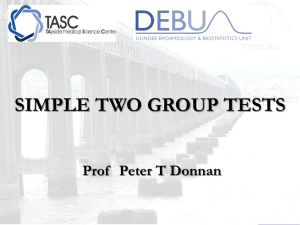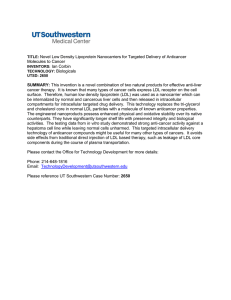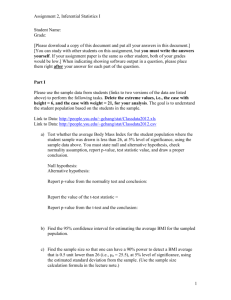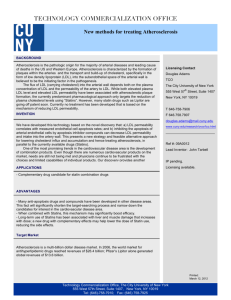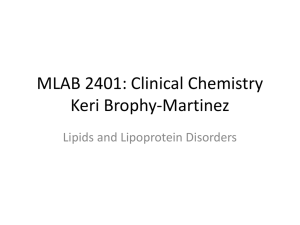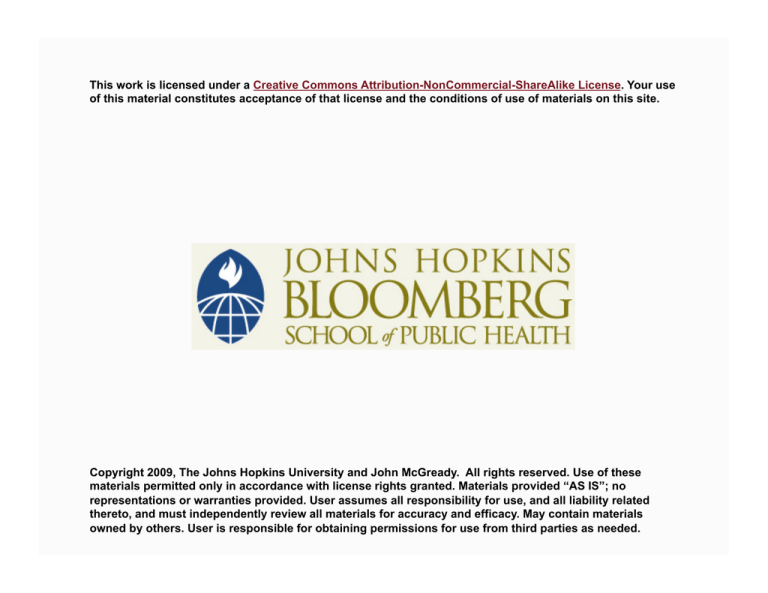
This work is licensed under a Creative Commons Attribution-NonCommercial-ShareAlike License. Your use
of this material constitutes acceptance of that license and the conditions of use of materials on this site.
Copyright 2009, The Johns Hopkins University and John McGready. All rights reserved. Use of these
materials permitted only in accordance with license rights granted. Materials provided “AS IS”; no
representations or warranties provided. User assumes all responsibility for use, and all liability related
thereto, and must independently review all materials for accuracy and efficacy. May contain materials
owned by others. User is responsible for obtaining permissions for use from third parties as needed.
Section C
Two Sample t-test, Approach with Smaller Samples
Sampling Distribution
What is sampling distribution of the difference in sample means?
- If either (or both) sample sizes are less than 60, a t-distribution
is used with n1 + n2 -2 degrees of freedom: this is the degrees of
freedom for the total sample size from both groups minus two
3
Two Sample t-test
Example
- In a randomized design, 23 patients with hyperlipidemia were
randomized to either take Treatment A or Treatment B for 12
weeks
- 12 patients assigned to Treatment A
- 11 patients assigned to Treatment B
4
Two Sample t-test
Example
- LDL cholesterol levels (mmol/L) measured on each subject at
baseline, and 12 weeks after start of study
- The 12-week change in LDL cholesterol was computed for each
subject
5
Two Sample t-test
Summary of results:
Treatment Group
A
B
12
11
Mean LDL change (mmol/L)
Post-trt less pre-trt
-1.41
-0.32
Standard deviation of
LDL changes (mmol/L)
0.55
0.65
Number of subjects (n)
6
Two Sample t-test
Scientific question
- Is there a difference in LDL change between the two treatment
groups?
Methods of inference
- Confidence interval for the difference in mean LDL cholesterol
will change between the two groups
- Statistical hypothesis test
7
95% Confidence Interval for Difference in Means
The general formula (large samples):
The general formula (“smaller” samples):
8
Two Sample t-test
Sample mean difference and estimated standard error:
Treatment Group
A
B
12
11
Mean LDL change (mmol/L)
Post-trt less pre-trt
-1.41
-0.32
Standard deviation of
LDL changes (mmol/L)
0.55
0.65
Number of subjects (n)
9
95% CI for Difference in Means: Hyperlipidemia Ex
How many standard errors to add and subtract?
- Since sample sizes are small we will have to add slightly more
than two standard errors
Number we need add and subtract for 95% confidence comes from a
t-distribution with (12 + 11 - 2 = 21 ) degrees of freedom
- From t-table this value is 2.08
So, 95% CI for true mean difference in change in LDL cholesterol,
drug A to drug B
10
Hypothesis Test to Compare Two Independent Groups
Two-sample (unpaired) t-test: getting a p-value
Is the change in LDL cholesterol the same in the two treatment
groups?
- Ho: µ1 = µ2 → Ho: µ1-µ2 = 0
- HA: µ1 ≠ µ2 → HA: µ1-µ2 ≠ 0
11
Hypothesis Test to Compare Two Independent Groups
Recall, general “recipe” for hypothesis testing . . .
1. Start by assuming Ho true
2. Measure distance of sample result from µo (here again its 0)
3. Compare test statistic (distance) to appropriate distribution to
get p-value
12
Diet Type and Weight Loss Study
In the diet types and weight loss study, recall:
So in this study:
-
So this study result was 4.4 standard errors below the null mean
of 0 (i.e., 4.4 standard errors from the less expected mean
difference in cholesterol change between the two treatments if
null was true)
13
How Are p-values Calculated?
Is a result 4.4 standard errors below 0 unusual?
- It depends on what kind of distribution we are dealing with
The p-value is the probability of getting a test statistic (distance) as
or more extreme than what you observed (-4.4) by chance if it was
true
The p-value comes from the sampling distribution of the difference
in two sample means
What is the sampling distribution of the difference in sample means?
- t-distribution with 12 + 1 – 2 = 21 degrees of freedom
14
Hyperlipidemia Example
To compute a p-value, we would need to compute the probability of
being 4.4 or more standard errors away from 0 on a t-distribution
with 21 degrees of freedom
15
Using Stata
Command syntax:
- ttesti
, unequal
16
Using Stata
Command syntax:
- ttesti
, unequal
17
Using Stata
Command syntax:
- ttesti
, unequal
18
Summary: Weight Loss Example
Statistical method
- Twenty-three patients with hyperlipidemia were randomly
assigned to one of two treatment groups: Treatment A or
Treatment B
- 12 patients were assigned to receive Treatment A
- 11 patients were assigned to receive Treatment B
19
Summary: Weight Loss Example
Statistical method
- Baseline LDL cholesterol measurements were taken on each
subject, and LDL was again measured after 12 weeks of
treatment
- The change in LDL cholesterol was computed for each subject
- The mean LDL changes in the two treatment groups were
compared using an unpaired t-test and a 95% confidence
interval was constructed for the difference in mean LDL
changes
20
Summary: Weight Loss Example
Result
- Patients on treatment A showed a decrease in LDL cholesterol
of 1.41 mmol/L and subjects on treatment B showed a decrease
of .32 mmol/L (a difference of 1.09 mmol/L, 95% CI .57 to 1.61
mmol/L)
- The difference in LDL changes was statistically significant
(p < .001)
21


